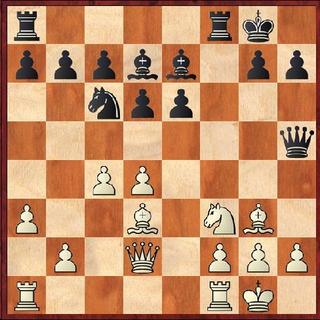Black to Play
Published in Chess Puzzles

A reader sent me an email asking for suggestions on how you should think to solve these puzzles. Was there some sort of system? This was my answer: For mating attacks it's recognizing certain patterns that are possible: Anastasia mate, back rank mate, Boden mate, etc., that I have spent a lot of time on in this column. For just "winning" the general rule is to look for checks, captures and forced moves. There are a whole bunch of themes with that, too: deflection, decoy, discovered attack, forks, exposing the king, interference, line clearance, the overworked piece, etc. We've done that as well in the column. I don't always bunch them. My best suggestion is to purchase the "Chess Training Pocket Book" by Lev Alburt. He has all his positions categorized in an index at the end. If you go through all 300 positions, you'll find yourself recognizing more and more patterns.
This past week I played three games that caused me to think about my answer. How would I explain why I did what I did? Here’s one position that arose. There are several good moves here. See if you can figure out what I did and why.
Solution:
The game went like this: 1.Nf3 f5 2.d4 Nf6 3.Bf4 e6 4.e3 d6 5.Nc3 Be7 6.Bd3 0–0 7.0–0 Nc6 8.a3 Bd7 9.Qd2 Qe8 10.e4 fxe4 11.Nxe4 Qh5 12.Ng3 Qf7 13.c4 Nh5 14.Nxh5 Qxh5 15.Bg3 and now we arrive at the diagram. I can play several moves here, but the one that hit me right off the bat was: 15… Rxf3 Why is that? A key idea in kingside attack is to break up a castled position’s pawn structure. The exchange sacrifice of rook for knight is common; however, what did I see to follow up with? I considered several “candidates.” One was playing e5 so I could use the bishop to attack the weak light squares in White’s position. One was improving my bishop placement with Bf6 and another was simply to bring the Rf8. I decided on the bishop move because it coordinated well with the knight attack on d4. My opponent didn’t quite get how important a N on d4 would be: 16.gxf3 Bf6 17.d5 exd5 18.cxd5 Nd4 19.Be4 Re8 20.Rac1 Rxe4 21.fxe4 Nf3+ 22.Kg2 Nxd2 23.Rfe1 Bh3+ and White finally resigned. So, this was pattern recognition (exchange sac), breaking up a castled position (exchange sac) and piece placement (coordinating occupation of d4). There were other possibilities, but for a teaching moment I hope this accomplishes the point I made in the original letter to the reader.
Send questions and comments to PTamburro@aol.com.






